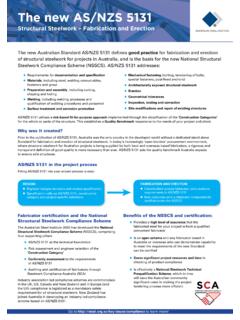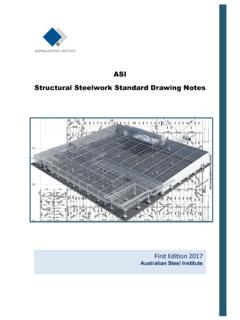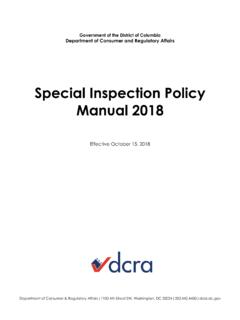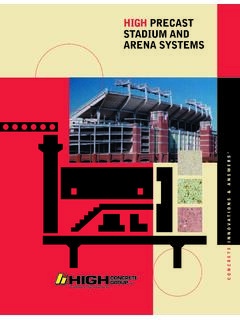Transcription of AS/NZS 5131 & AS 4100 - Steel
1 OVERVIEWOn 14th August 2020, Standards Australia published an amendment to AS/NZS 5131:2016 Structural steelwork fabrication and erection . Following this, on 21st August 2020, Standards Australia published a revision to AS 4100 Steel 4100 and AS/NZS 5131 work together to ensure risk-minimised, fit-for-purpose design and construction outcomes for Steel structures. They are therefore significant for all members of the Steel supply chain, including Steel manufacturers, distributors, Steel detailers, fabricators, erectors, designers, constructors and certifiers.
2 All members of the Steel supply chain should be aware of the 2020 changes to these Standards, the implications for their business and business relationships, and their duty of care under both Workplace Health and Safety (WHS) and National Construction Code (NCC) CONTEXTF abrication and erection of structural Steel was previously addressed in two chapters of AS 4100. This was in sharp contrast to the situation in America, Canada, Europe and the UK. In each of these first-world countries, fabrication of structural Steel is referenced to a self-standing separate Standard or specification, usually of a few hundred pages in ensure Australia maintained a baseline of internationally accepted good practice and clearly defined quality standards, the Australian Steel Institute (ASI)
3 Developed a fabrication and erection Code of Practice, with agreement from Standards Australia that it would be submitted to become the first Standard for fabrication and erection of structural Steel in Australia and New Zealand. The new Standard, AS/NZS 5131 Structural steelwork - fabrication and erection , was published in the publication of AS/NZS 5131, the next step was to revise AS 4100 to reference AS/NZS 5131 and remove the existing requirements for fabrication and erection from AS 4100. Significantly, as AS 4100 is a primary reference under the National Construction Code (NCC), referencing AS/NZS 5131 from AS 4100 will effectively make AS/NZS 5131 a secondary reference under the 5131 & AS 4100 2020 UPDATE: SUMMARY OF CHANGES AND IMPLICATIONSAs AS 4100 is a primary reference under the National Construction Code (NCC), referencing AS/NZS 5131 from AS 4100 will effectively make AS/NZS 5131 a secondary reference under the 5131 & AS 4100: 2020 UPDATE TABLE 1.
4 TYPES OF TRACEABILITYTYPEDEFINITIONLotFor lot traceability, the material for a lot of identically fabricated components (main members, purlin cleats, etc.) shall be traceable back to a set of parent material test certificates, but an individual test certificate cannot be assigned to an individual piece of material within that lot of components. Material identification shall be transferred when part material is returned to stock and before further being allocated to other piece-mark traceability, the raw material or fabricated component shall be traceable to the parent material test certificates at all stages through fabrication to incorporation into the works on-site, for each piece-mark, of which there may be many individual pieces.
5 Raw material including all plate and section bought or allocated from stock for the work shall be correlated to the test certificates and incoming inspection records. Material identification shall be transferred when part material is returned to stock and before further being allocated to other piece traceability, the raw material or fabricated component shall be traceable to the parent material test certificates at all stages through fabrication to incorporation into the works on-site, for each piece of Steel . Raw material including all plate and section bought or allocated from stock for the work shall be correlated to the test certificates and incoming inspection records.
6 Material identification shall be transferred when part material is returned to stock and before further being allocated to other 2: BASELINE REQUIREMENT FOR EACH CONSTRUCTION CATEGORY (CC)CONSTRUCTIONCATEGORYBASELINE REQUIREMENTC onstruction Category 1 (CC1)Test certificates shall be available for all Steel material. The grade of Steel shall remain identifiable for all Steel material. Individual plate and section components shall be marked or otherwise designated to ensure the grade can be correlated directly with the fabrication drawing or Category 2 (CC2)Test certificates shall be provided for all Steel material.
7 Lot traceability for main structural members, connections between main structural members and major plate components (for fabricated plate web girders and the like).Construction Categories 3 (CC3) and 4 (CC4)Test certificates shall be provided for all Steel material. Lot traceability for all items (including cleats, brackets and the like). Piece or piece-mark traceability is required if so designated in the construction TO AS/NZS 5131 The amendments of significance that have been made to AS/NZS 5131 include:TraceabilityModifications to the definitions (Section 4) and application (Section 5) of traceability have been made to better align with international practice.
8 There are now three types of traceability, lot, piece-mark and piece, as further explained in Table 1 (below). The type of traceability is applied over an extent of components on the project, where the extent is defined in relation to the Construction Category, as further defined in Table 2 (below). In effect, the requirements for traceability have been unpacked to allow more responsive baseline of lot traceability is required for Construction Categories CC2, CC3 and CC4, with no specified traceability for CC1.
9 Optional piece-mark or piece traceability may be selected by the specifier if, and only if, required for CC3 and CC4. The baseline requirement for each Construction Category is indicated in Table 2. The baseline requirements are better aligned with international practice in this area. AS/NZS 5131 & AS 4100: 2020 UPDATE Apart from unpacking traceability to make it more flexible in its application, the significant difference with the 2020 amendment to AS/NZS 5131 is that lot traceability is the baseline for the CC2, CC3 and CC4 construction categories.
10 The extent of application from main members to all members and components varies between the construction categories. For CC3 and CC4, the specifier may choose to require increased type traceability, either piece-mark or piece traceability. The previous version of AS/NZS 5131 required, in effect, piece traceability for all components for the higher construction categories. The application of traceability has been one of the significant functional requirements for fabricators. ASI believes that this amendment makes traceability better aligned with industry expectations and international good ISO 3834In AS/NZS 5131:2020 there is now normative reference to AS/NZS ISO 3834 Quality requirements for fusion weldingof metallic materials, which was previously an informative reference.






